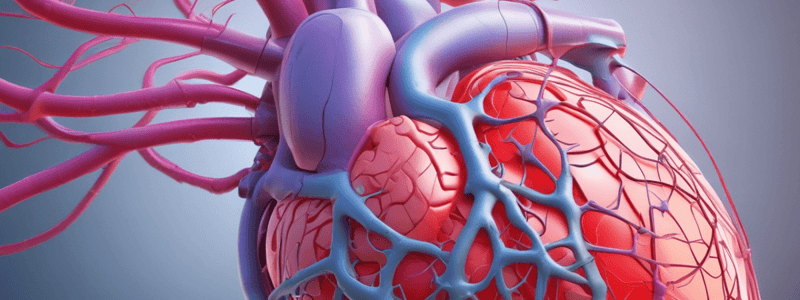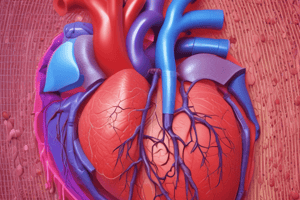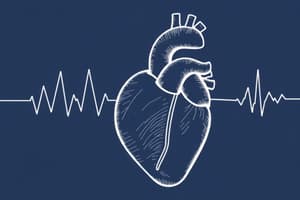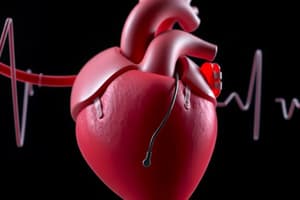Podcast
Questions and Answers
During which phase of the cardiac cycle are all valves closed?
During which phase of the cardiac cycle are all valves closed?
- Isometric contraction (correct)
- Slow filling
- Rapid ejection
- Atrial systole
What is the characteristic sound heard at the end of the second heart sound?
What is the characteristic sound heard at the end of the second heart sound?
- Snap
- Murmur
- Click (correct)
- Gurgle
In aortic stenosis, why does the left ventricle have to generate more pressure?
In aortic stenosis, why does the left ventricle have to generate more pressure?
- To open the AV valve
- To open the semilunar valve
- To decrease blood flow to the carotid arteries
- To overcome stiffening of the aortic valve (correct)
What does the U wave on an ECG indicate?
What does the U wave on an ECG indicate?
Which phase of the cardiac cycle sees a marked increase in ventricular volume?
Which phase of the cardiac cycle sees a marked increase in ventricular volume?
Why does a jet of blood radiate to the carotid arteries in aortic stenosis?
Why does a jet of blood radiate to the carotid arteries in aortic stenosis?
During which phase of the cardiac cycle do the AV valves close and the semilunar valves open?
During which phase of the cardiac cycle do the AV valves close and the semilunar valves open?
Which event occurs during the isometric relaxation phase?
Which event occurs during the isometric relaxation phase?
What is the approximate duration of the whole cardiac cycle when the heart rate is 75 beats per minute?
What is the approximate duration of the whole cardiac cycle when the heart rate is 75 beats per minute?
During which phase does ventricular filling occur?
During which phase does ventricular filling occur?
Which heart sound is associated with the isometric contraction phase?
Which heart sound is associated with the isometric contraction phase?
What happens to atrial pressure during the atrial systolic phase?
What happens to atrial pressure during the atrial systolic phase?
What happens during the isometric (isovolumic) contraction phase?
What happens during the isometric (isovolumic) contraction phase?
During which phase does the ventricular pressure markedly increase and become greater than the aortic pressure?
During which phase does the ventricular pressure markedly increase and become greater than the aortic pressure?
What happens to the aortic pressure during the slow (reduced) ejection phase?
What happens to the aortic pressure during the slow (reduced) ejection phase?
When do the semilunar valves close during the cardiac cycle?
When do the semilunar valves close during the cardiac cycle?
Which phase is characterized by a sharp decrease in aortic pressure followed by an increase (diacrotic notch)?
Which phase is characterized by a sharp decrease in aortic pressure followed by an increase (diacrotic notch)?
During which phase does the atrial pressure become greater than the ventricular pressure?
During which phase does the atrial pressure become greater than the ventricular pressure?
Flashcards are hidden until you start studying




